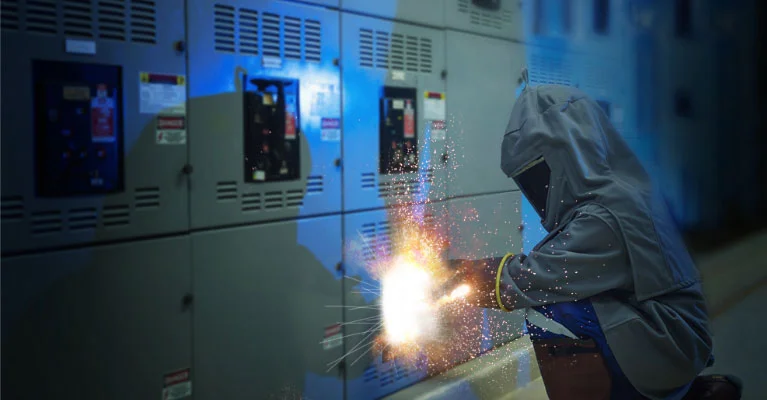Arc flash is a dangerous electrical phenomenon that occurs when an electric current passes through the air between ungrounded conductors or between a conductor and the ground. The resulting explosion can produce intense heat, bright light, and a pressure wave capable of causing severe injury or even death. Understanding arc flash hazards, implementing effective controls, and preparing for emergencies are critical steps in protecting workers and maintaining a safe electrical environment.
What is an Arc Flash?
- Definition: An arc flash is a rapid release of energy caused by an electrical fault that produces a high-temperature, high-pressure discharge.
- Causes: It typically occurs when a fault, such as a short circuit or equipment failure, allows current to flow through the air.
- Consequences: The energy released can lead to burns, blindness, hearing loss, and other injuries, along with potential damage to equipment and facilities.
Hazards Associated with Arc Flash
- Extreme Temperatures: Arc flashes can reach temperatures of up to 35,000°F, capable of vaporizing metal and igniting clothing.
- Pressure Waves: The explosive nature of an arc flash can produce a shock wave that may cause blunt force trauma.
- Intense Light and UV Radiation: The bright flash and ultraviolet radiation can result in temporary or permanent vision impairment.
- Burn Injuries: Direct exposure can lead to severe thermal burns on the skin and underlying tissues.
Risk Factors
Several factors increase the likelihood and severity of an arc flash:
- High Voltage and Current: Systems operating at high voltages or with large fault currents are at greater risk.
- Equipment Age and Condition: Deteriorating insulation, poor maintenance, and outdated equipment can contribute to arc flash incidents.
- Improper Work Practices: Inadequate training, lack of proper PPE, or failure to follow lockout/tagout procedures can elevate the risk.
- Environmental Conditions: Dust, moisture, and conductive contaminants can also create conditions conducive to an arc flash.
Engineering and Administrative Controls
Engineering Controls
- Proper System Design: Design electrical systems to minimize potential fault paths and incorporate adequate separation between conductive components.
- Arc Flash Protection Devices: Install arc flash relays, current-limiting fuses, and rapid shutdown mechanisms to reduce the energy released during an incident.
- Regular Maintenance and Inspections: Routine testing and maintenance of electrical equipment help identify potential hazards before they lead to an arc flash.
Administrative Controls
- Risk Assessments: Conduct arc flash hazard analyses to determine incident energy levels and establish safe work boundaries.
- Labeling: Clearly label equipment with arc flash warning labels that detail the incident energy and required PPE levels.
- Standard Operating Procedures (SOPs): Develop and enforce SOPs that include lockout/tagout procedures, proper tool usage, and safe work practices around energized equipment.
Personal Protective Equipment (PPE)
To protect workers from the hazards of arc flash, appropriate PPE is essential:
- Flame-Resistant Clothing: Wear arc-rated clothing, including coveralls, gloves, and hoods, designed to withstand high temperatures.
- Face and Eye Protection: Use arc-rated face shields and safety glasses to protect against intense light and flying debris.
- Hearing Protection: In high-risk areas, hearing protection devices such as earplugs or earmuffs can mitigate the risk of hearing damage.
Training and Emergency Preparedness
- Employee Training: Regular training programs should cover arc flash hazards, safe work practices, and the proper use of PPE. Training should include both classroom instruction and hands-on exercises.
- Emergency Response Planning: Develop comprehensive emergency plans that outline evacuation routes, first-aid procedures, and communication protocols in the event of an arc flash incident.
- Drills and Simulations: Conduct regular drills to ensure all personnel are familiar with emergency procedures and can react quickly if an incident occurs.
Conclusion
Arc flash is a significant hazard in electrical systems that demands a proactive, multifaceted approach to safety. By understanding the causes and risks associated with arc flash, implementing robust engineering and administrative controls, providing proper PPE, and ensuring thorough training and emergency preparedness, organizations can greatly reduce the likelihood of an incident and minimize its impact if it occurs.
A commitment to arc flash safety not only protects workers from severe injury but also contributes to the overall reliability and efficiency of electrical operations. Embracing these best practices is essential for fostering a safe working environment in any industry dealing with electrical systems.
Discover more from HSEProHub
Subscribe to get the latest posts sent to your email.



